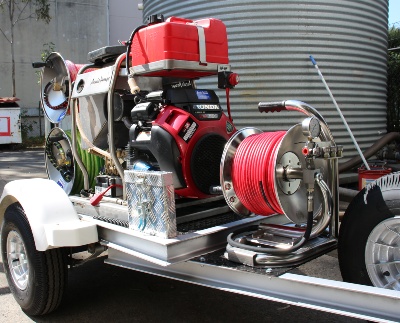The summer of 2019/20 was a bitter lesson. Not just for homeowners but for the firefighting authorities as well.
Although they did a brilliant job of rising to the occasion, we learnt that nature is still the “boss” and will continue to set us major challenges as we see bushfires, floods and droughts become more prevalent. This is not just in Australia, but around the globe!
As we put this story together for PEA, California is burning and has been now for weeks.
LOOKING BACK
During the Christmas of 2019 fires raged through the south coast of New South Wales and into Victoria. Settlements were wiped out, lives lost, stock and property destroyed. Bawley Point, Tabourie, Burrill Lake, and all points south, including Batemans Bay, Cobargo and Tilba, were disaster areas.
Geoff Coller, living in the “urban interface” at Bawley Point, had his home saved by the amazing action of the RFS volunteers. Geoff’s beautiful house is in a cleared acreage, surrounded by forest. He and his wife got out but, thought they would see their house burning on television. Instead, they saw the News showing their house being saved by the volunteers, taking enormous risk to penetrate the forest to get to the house and save it.
Amazing people, amazing efforts, but huge risks taken in the “heat of the moment.
GLOBAL FIRE RISK
Changing weather patterns, having an undeniable impact on the risk of forest fires, not just in Australia, but around the world. California is regarded by the experts as being the number one potential area of risk for humans whilst southern France, the Dandenongs in Victoria and some sections of Chile are regarded as the potential major danger spots.
We learnt during the summer of 2019/20-that what may appear to be the danger spots is not necessarily where the fire chooses to be. In fact, the river fire in Monterey County, California burnt through National Parks, largely uncontrolled for weeks. That it didn’t wipe out more homes than is a tribute to the efforts of homeowners themselves and the fearless firefighting volunteers!
Even today, we’re still hearing stories of the risks taken by these men and women, some as young as 17, who put their lives in jeopardy to try and save the lives and property in their communities.
What did we learn? We learnt that nature is still the boss and we have a long way to go before we can come to terms with the compatibility of 7.8 billion people on the planet and our desire to live lives that are close to bushland!
THE CHALLENGE OF THE URBAN INTERFACE
With well over a million homeowners living in the leafy environments surrounding the towns and major capital cities, fire services are rightly concerned about the jeopardy to property and lives.
Aussie Pumps is located at Castle Hill, the centre of the Hills district of Sydney. We love our leafy suburbs and outer “blockies” areas, where the houses are all on the top of the ridge, with valleys and gullies descending into national park and bushland. Even within a kilometre of our 2 ½ acre factory, we have gullies loaded with huge fuel loads.
The rain of the last couple of years has been great for farmers but it has built up a huge amount of underbrush, increasing the danger areas in key capital cities, towns and villages.
Are the people trained to protect themselves? No, not really, Here at Aussie Pumps, we produce thousands of Aussie Bushfire Survival Guides that give homeowners good advice about how to prepare themselves for bushfire. They are including instructions on how to train for the worst! We do that to support the efforts the Government makes as well with their great television ads warning people about the fire danger.
In spite of that, 90 percent of homes in these danger areas are not protected and the homeowners are not trained to defend their property. That being the case and having to accept that is a reality, we have to then look at how we can possibly get on top of the next disaster. That may be only weeks away from the printing of this magazine!
With a million houses in jeopardy, possibly double that, we have to ask why Local Government isn’t taking a stronger position. It’s almost as if they are disconnected to the efforts made by the volunteers and the firefighting authorities to try to help homeowners protect themselves. The point is councils approve the building of structures in these high danger.
THE FUTURE OF FIREFIGHTING
In a perfect world, we would see homeowners trained, and everybody having a 20,000 litre water tank, swimming pool, dam or other water resource and a firefighting pump with sprinklers around the house. They could be prepped with cleared areas around all buildings.
In other words, all the steps that a logical person would take to protect their home if they thought a bushfire could happen to them. The problem is, most people think it will happen to somewhere else, not their suburb!
Will Local Government ever get involved? We can only hope there will become requirements for homes to fulfill certain requirements in preparation and equipment for those who want to live among the trees.
FIGHTING FIRE FROM THE AIR
The real future for bush firefighting as we see it, is aerial bombardment. There are brilliant people working on polishing up the idea of firefighting from the air. This concept is what knocked over the Fraser Island fires last year and played a vital part in the final elimination of the Perth fires that raged for weeks before the right aircraft with the right capacity were used to demolish those fires. Here is what we are learning about aerial firefighting.
- Chemicals that get the job done are being perfected with machinery that will deliver a “fast-fill” ability to increase the number of sorties flown.
- This season will see Sea hawk helicopters (converted to “Fire Hawks”) carrying up to 3,000 – 4,000 litres of retardant. At least eight Chinooks with a huge capacity to dump well over 20,000 litres per drop will also be on duty. The Fire Hawks can also be equipped with firefighting nozzles that will enable them to pinpoint the targets
The final evolution of this aerial firefighting will be the ability to work at night, with pilots using sophisticated night vision equipment that enables them to move faster to the fires and fly sorties in a period where the fire is less active, with the temperature and wind dropping at night, making it safer and firefighting more effective.
TWIGGY’S DREAM
Twiggy Forrest is not only an iron ore magnate, but also a man who believes in putting ideas into practice. His dream is 1500 helicopters spread from Perth, all the way through to the Pilbara. They will have the ability to carry not only freight and passengers, but also double as a bush firefighting force. This inspiration is based on the concept that fires should be put out within less than two hours of starting In other words, to nip the fire in the bud so to speak.
What an idea!
THE FIRE SERVICES GET ON BOARD
New techniques, new equipment and new ideas will help us to control future fires. The question is, how fast can we bring these new concepts into action? We don’t ever want to see a repeat of the horrors of the summer of 2020.
In spite of that, we all have to face the fact we are only a matter of weeks away from the next fire season and there is a huge fuel build up to be dealt with.
Who is going to save the Urban Interface?
This story was written by Warwick Lorenz, General Manger of Australian Pump Industries.






